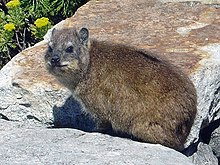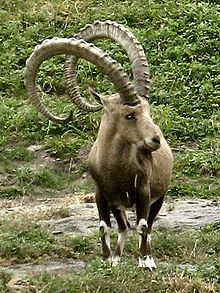List of mammals of Oman
This is a list of the mammal species recorded in Oman. There are at least 62 mammal species in Oman that have been assessed by the International Union for Conservation of Nature (IUCN), of which 1 is critically endangered, 4 are endangered, 8 are vulnerable, and 2 are near-threatened.[1]
The following tags are used to highlight each species' conservation status as assessed by the IUCN:
| EX | Extinct | No reasonable doubt that the last individual has died. |
| EW | Extinct in the wild | Known only to survive in captivity or as a naturalized populations well outside its previous range. |
| CR | Critically endangered | The species is in imminent risk of extinction in the wild. |
| EN | Endangered | The species is facing an extremely high risk of extinction in the wild. |
| VU | Vulnerable | The species is facing a high risk of extinction in the wild. |
| NT | Near threatened | The species does not meet any of the criteria that would categorise it as risking extinction but it is likely to do so in the future. |
| LC | Least concern | There are no current identifiable risks to the species. |
| DD | Data deficient | There is inadequate information to make an assessment of the risks to this species. |
Some species were assessed using an earlier set of criteria. Species assessed using this system have the following instead of near threatened and least concern categories:
| LR/cd | Lower risk/conservation dependent | Species which were the focus of conservation programmes and may have moved into a higher risk category if that programme was discontinued. |
| LR/nt | Lower risk/near threatened | Species which are close to being classified as vulnerable but are not the subject of conservation programmes. |
| LR/lc | Lower risk/least concern | Species for which there are no identifiable risks. |
Subclass: Theria
Infraclass: Eutheria
Order: Hyracoidea (hyraxes)

The hyraxes are any of four species of fairly small, thickset, herbivorous mammals in the order Hyracoidea. About the size of a domestic cat they are well-furred, with rounded bodies and a stumpy tail. They are native to Africa and the Middle East.
- Family: Procaviidae (hyraxes)
- Genus: Procavia
- Cape hyrax, Procavia capensis LC
- Genus: Procavia
Order: Sirenia (manatees and dugongs)

Sirenia is an order of fully aquatic, herbivorous mammals that inhabit rivers, estuaries, coastal marine waters, swamps, and marine wetlands. All four species are endangered.
- Family: Dugongidae
Order: Rodentia (rodents)
Rodents make up the largest order of mammals, with over 40 percent of mammalian species. They have two incisors in the upper and lower jaw which grow continually and must be keep short by gnawing. Most rodents are small though the capybara can weigh up to 45 kg (100 lb).
- Suborder: Sciurognathi
- Family: Dipodidae (jerboas)
- Subfamily: Dipodinae
- Genus: Jaculus
- Lesser Egyptian jerboa, Jaculus jaculus LC
- Genus: Jaculus
- Subfamily: Dipodinae
- Family: Muridae (mice, rats, voles, gerbils, hamsters, etc.)
- Subfamily: Deomyinae
- Genus: Acomys
- Cairo spiny mouse, Acomys cahirinus LC
- Golden spiny mouse, Acomys russatus LR/lc
- Genus: Acomys
- Subfamily: Gerbillinae
- Genus: Gerbillus
- Cheesman's gerbil, Gerbillus cheesmani LR/lc
- Wagner's gerbil, Gerbillus dasyurus LR/lc
- Pygmy gerbil, Gerbillus henleyi LC
- Gerbillus nanus LC
- Genus: Meriones
- Arabian jird, Meriones arimalius EN
- Genus: Gerbillus
- Subfamily: Deomyinae
- Family: Dipodidae (jerboas)
Order: Erinaceomorpha (hedgehogs and gymnures)
The order Erinaceomorpha contains a single family, Erinaceidae, which comprise the hedgehogs and gymnures. The hedgehogs are easily recognised by their spines while gymnures look more like large rats.
- Family: Erinaceidae (hedgehogs)
- Subfamily: Erinaceinae
- Genus: Hemiechinus
- Desert hedgehog, Hemiechinus aethiopicus LR/lc
- Genus: Hemiechinus
- Subfamily: Erinaceinae
Order: Soricomorpha (shrews, moles, and solenodons)
The "shrew-forms" are insectivorous mammals. The shrews and solenodons closely resemble mice while the moles are stout-bodied burrowers.
- Family: Soricidae (shrews)
- Subfamily: Crocidurinae
- Genus: Crocidura
- Arabian shrew, Crocidura arabica LR/lc
- Dhofar shrew, Crocidura dhofarensis CR
- Genus: Crocidura
- Subfamily: Crocidurinae
Order: Chiroptera (bats)
The bats' most distinguishing feature is that their forelimbs are developed as wings, making them the only mammals in the world naturally capable of flight. Bat species account for about 20% of all mammals.
- Family: Pteropodidae (flying foxes, Old World fruit bats)
- Subfamily: Pteropodinae
- Genus: Rousettus
- Egyptian fruit bat, Rousettus aegyptiacus LC
- Genus: Rousettus
- Subfamily: Pteropodinae
- Family: Vespertilionidae
- Subfamily: Myotinae
- Genus: Myotis
- Geoffroy's bat, Myotis emarginatus VU
- Genus: Myotis
- Subfamily: Vespertilioninae
- Genus: Eptesicus
- Botta's serotine, Eptesicus bottae LC
- Sind bat, Eptesicus nasutus VU
- Genus: Hypsugo
- Arabian pipistrelle, Hypsugo arabicus VU
- Bodenheimer's pipistrelle, Hypsugo bodenheimeri LR/nt
- Genus: Nyctalus
- Common noctule, Nyctalus noctula LR/lc
- Genus: Otonycteris
- Desert long-eared bat, Otonycteris hemprichii LR/lc
- Genus: Pipistrellus
- Kuhl's pipistrelle, Pipistrellus kuhlii LC
- Genus: Eptesicus
- Subfamily: Myotinae
- Family: Rhinopomatidae
- Genus: Rhinopoma
- Lesser mouse-tailed bat, Rhinopoma hardwickei LC
- Greater mouse-tailed bat, Rhinopoma microphyllum LC
- Small mouse-tailed bat, Rhinopoma muscatellum LR/lc
- Genus: Rhinopoma
- Family: Molossidae
- Genus: Tadarida
- Egyptian free-tailed bat, Tadarida aegyptiaca LC
- Genus: Tadarida
- Family: Rhinolophidae
- Subfamily: Rhinolophinae
- Genus: Rhinolophus
- Blasius's horseshoe bat, Rhinolophus blasii NT
- Geoffroy's horseshoe bat, Rhinolophus clivosus LC
- Genus: Rhinolophus
- Subfamily: Hipposiderinae
- Genus: Asellia
- Trident leaf-nosed bat, Asellia tridens LC
- Genus: Triaenops
- Persian trident bat, Triaenops persicus LC
- Genus: Asellia
- Subfamily: Rhinolophinae
Order: Cetacea (whales)



The order Cetacea includes whales, dolphins and porpoises. They are the mammals most fully adapted to aquatic life with a spindle-shaped nearly hairless body, protected by a thick layer of blubber, and forelimbs and tail modified to provide propulsion underwater.
- Suborder: Mysticeti
- Family: Balaenidae
- Family: Balaenopteridae
- Subfamily: Balaenopterinae
- Genus: Balaenoptera
- Blue whale, Balaenoptera musculus EN
- Genus: Balaenoptera
- Subfamily: Megapterinae
- Genus: Megaptera
- Humpback whale, Megaptera novaeangliae VU Critically endangered, and the most isolated population in the world
- Genus: Megaptera
- Subfamily: Balaenopterinae
- Suborder: Odontoceti
- Superfamily: Platanistoidea
- Family: Phocoenidae
- Genus: Neophocaena
- Finless porpoise, Neophocaena phocaenoides DD
- Genus: Neophocaena
- Family:Physeteridae
- Genus: Physeter
- Sperm whale, Physeter macrocephalus VU
- Genus: Physeter
- Family: Kogiidae
- Genus: Kogia
- Pygmy sperm whale, Kogia breviceps LR/lc
- Dwarf sperm whale, Kogia sima LR/lc
- Genus: Kogia
- Family: Ziphidae
- Subfamily: Hyperoodontinae
- Genus: Mesoplodon
- Blainville's beaked whale, Mesoplodon densirostris DD
- Genus: Mesoplodon
- Subfamily: Hyperoodontinae
- Family: Delphinidae (marine dolphins)
- Genus: Steno
- Rough-toothed dolphin, Steno bredanensis DD
- Genus: Sousa
- Genus: Tursiops
- Bottlenose dolphin, Tursiops aduncus DD
- Genus: Stenella
- Pantropical spotted dolphin, Stenella attenuata LR/cd
- Striped dolphin, Stenella coeruleoalba LR/cd
- Spinner dolphin, Stenella longirostris LR/cd
- Genus: Delphinus
- Common dolphin, Delphinus capensis LR/lc
- Genus: Lagenodelphis
- Fraser's dolphin, Lagenodelphis hosei DD
- Genus: Grampus
- Risso's dolphin, Grampus griseus DD
- Genus: Feresa
- Pygmy killer whale, Feresa attenuata DD
- Genus: Pseudorca
- False killer whale, Pseudorca crassidens LR/lc
- Genus: Orcinus
- Orca, Orcinus orca LR/cd
- Genus: Steno
- Family: Phocoenidae
- Superfamily: Platanistoidea
Order: Carnivora (carnivorans)


There are over 260 species of carnivorans, the majority of which feed primarily on meat. They have a characteristic skull shape and dentition.
- Suborder: Feliformia
- Family: Felidae (cats)[2]
- Subfamily: Felinae
- Subfamily: Pantherinae
- Genus: Panthera
- Arabian leopard, Panthera pardus nimr CR
- Genus: Panthera
- Family: Viverridae (civets, mongooses, etc.)
- Subfamily: Viverrinae
- Genus: Genetta
- Common genet, Genetta genetta LR/lc
- Genus: Genetta
- Subfamily: Viverrinae
- Family: Herpestidae (mongooses)
- Genus: Ichneumia
- White-tailed mongoose, Ichneumia albicauda LR/lc
- Genus: Ichneumia
- Family: Hyaenidae (hyaenas)
- Genus: Hyaena
- Striped hyena, Hyaena hyaena NT
- Genus: Hyaena
- Family: Felidae (cats)[2]
- Suborder: Caniformia
- Family: Canidae (dogs, foxes)
- Genus: Vulpes
- Blanford's fox, Vulpes cana VU
- Ruppell's fox, Vulpes ruppellii DD
- Arabian red fox, Vulpes vulpes arabica LC[4]
- Genus: Canis
- Golden jackal, Canis aureus LC
- Gray wolf, Canis lupus LC
- Genus: Vulpes
- Family: Mustelidae (mustelids)
- Family: Canidae (dogs, foxes)
Order: Artiodactyla (even-toed ungulates)

The even-toed ungulates are ungulates whose weight is borne about equally by the third and fourth toes, rather than mostly or entirely by the third as in perissodactyls. There are about 220 artiodactyl species, including many that are of great economic importance to humans.
- Family: Bovidae (cattle, antelope, sheep, goats)
- Subfamily: Antilopinae
- Genus: Gazella
- Mountain gazelle, Gazella gazella VU
- Goitered gazelle, Gazella subgutturosa VU
- Genus: Gazella
- Subfamily: Caprinae
- Genus: Capra
- Wild goat, Capra aegagrus VU
- Nubian ibex, Capra nubiana EN
- Genus: Hemitragus
- Arabian tahr, Hemitragus jayakari EN
- Genus: Capra
- Subfamily: Hippotraginae
- Genus: Oryx
- Arabian oryx, Oryx leucoryx EN
- Genus: Oryx
- Subfamily: Antilopinae
See also
- List of chordate orders
- List of regional mammals lists
- List of prehistoric mammals
- Mammal classification
- New mammal species
Notes
- ^ This list is in part derived from the IUCN Red List which lists species of mammals and includes those mammals that have recently been classified as extinct (since 1500 AD). The taxonomy and naming of the individual species is based on those used in existing Wikipedia articles as of 21 May 2007 and supplemented by the common names and taxonomy from the IUCN, Smithsonian Institution, or University of Michigan where no Wikipedia article was available.
- ^ a b Wild Cats: Status Survey and Conservation Action Plan (PDF). Gland, Switzerland: IUCN/SSC Cat Specialist Group. 1996. pp. 1–344. ISBN 2-8317-0045-0.
{{cite book}}: Unknown parameter|authors=ignored (help) - ^ Template:IUCN
- ^ Castelló, José R. (2018). Canids of the World: Wolves, Wild Dogs, Foxes, Jackals, Coyotes, and Their Relatives. Princeton University Press. pp. 238–239. ISBN 9780691185415 – via Google Books.
References
- "The IUCN Red List of Threatened Species: Mammals of Oman". IUCN. 2001. Retrieved 22 May 2007. [dead link]
- "Mammal Species of the World". Smithsonian National Museum of Natural History. 2005. Archived from the original on 27 April 2007. Retrieved 22 May 2007.
{{cite web}}: Unknown parameter|deadurl=ignored (|url-status=suggested) (help) - "Animal Diversity Web". University of Michigan Museum of Zoology. 1995–2006. Retrieved 22 May 2007.
